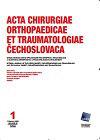High Femoral Antetorsion Is a Major Risk Factor for Anterior Knee Pain whereas Trochlea Dysplasia Predisposes for Patella Dislocation.
IF 0.4
4区 医学
Q4 ORTHOPEDICS
Acta chirurgiae orthopaedicae et traumatologiae Cechoslovaca
Pub Date : 2023-06-22
DOI:10.55095/achot2023/024
引用次数: 0
Abstract
PURPOSE OF THE STUDY Patellofemoral stability and congruency are influenced by different parameters. Their contribution to anterior knee pain and instability is not fully understood. We investigated, if isolated femoral antetorsion of more than 25° leads to patellofemoral instability. MATERIAL AND METHODS We analyzed 90 knees in patients with patellofemoral complaints and correlated clinical and radiological characteristics. Patients presenting at our center between January 2018 and December 2020 because of patellofemoral pain or instability were included, provided that there was no previous surgical intervention done. RESULTS The severity of trochlea dysplasia classified using the Oswestry-Bristol classification significantly correlated with events of patellofemoral dislocations. (χ=8.152, p=0.043, φ=0.288). All males with a history of patella dislocation had at least a mild trochlea dysplasia. The majority of females complaining about patellofemoral symptoms in general had a dysplastic trochlea. Patella alta is more frequently found in patients with trochlea dysplasia than in patients with a normal femoral trochlea anatomy. DISCUSSION The majority of unstable patellofemoral joints showed a dysplastic trochlea. A high femoral antetorsion was found to be an additional minor factor contributing to instability. Isolated high femoral antetorsion without trochlea dysplasia rather leads to anterior knee pain without patella dislocation. Furthermore, no direct significant correlation between patella alta and patellofemoral instability was found. Patella alta can therefore rather be seen as a result of a dysplastic trochlea than a primary major risk factor for patellofemoral instability. CONCLUSIONS Trochlea dysplasia is the major risk factor for patellofemoral instability. Patella alta can rather be seen as a result of a dysplastic trochlea than as a primary risk factor for patella instability or pain. Isolated high femoral antetorsion often leads to patellofemoral pain syndrome but not to patella dislocations. Key words: MPFL, patella instability, patellofemoral instability.股骨前扭转是膝前疼痛的主要危险因素,而髌关节脱位易发生Trochlea发育不良。
研究目的髌股关节的稳定性和一致性受不同参数的影响。它们对膝关节前部疼痛和不稳定的影响尚不完全清楚。我们调查了孤立的股骨前倾超过25°是否会导致髌股不稳定。材料和方法我们分析了90例髌股关节疾病患者的膝关节及其相关的临床和放射学特征。包括2018年1月至2020年12月期间因髌股疼痛或不稳定在我们中心就诊的患者,前提是之前没有进行过手术干预。结果使用Oswestry-Bstol分类法对滑车发育不良的严重程度进行分类,与髌股关节脱位事件显著相关。(χ=8.152,p=0.043,φ=0.288)。所有有髌骨脱位史的男性至少有一个轻度滑车发育不良。大多数抱怨髌股关节症状的女性滑车发育异常。滑车发育不良的患者比股骨滑车解剖结构正常的患者更常见高位髌骨。讨论大多数不稳定的髌股关节表现为滑车发育异常。高股骨前扭转被发现是导致不稳定的另一个次要因素。没有滑车发育不良的孤立性股骨高位前扭转反而导致没有髌骨脱位的膝前疼痛。此外,高位髌骨和髌股关节不稳定之间没有发现直接的显著相关性。因此,高位髌骨可以被视为滑车发育不良的结果,而不是髌股不稳定的主要风险因素。结论Trochlea发育不良是髌股关节不稳定的主要危险因素。高位髌骨可以被视为滑车发育不良的结果,而不是髌骨不稳定或疼痛的主要风险因素。孤立性股骨高位前扭转常导致髌股疼痛综合征,但不会导致髌骨脱位。关键词:MPFL,髌骨不稳定,髌股不稳定。
本文章由计算机程序翻译,如有差异,请以英文原文为准。
求助全文
约1分钟内获得全文
求助全文
来源期刊
CiteScore
0.70
自引率
25.00%
发文量
53
期刊介绍:
Editorial Board accepts for publication articles, reports from congresses, fellowships, book reviews, reports concerning activities of orthopaedic and other relating specialised societies, reports on anniversaries of outstanding personalities in orthopaedics and announcements of congresses and symposia being prepared. Articles include original papers, case reports and current concepts reviews and recently also instructional lectures.

 求助内容:
求助内容: 应助结果提醒方式:
应助结果提醒方式:


